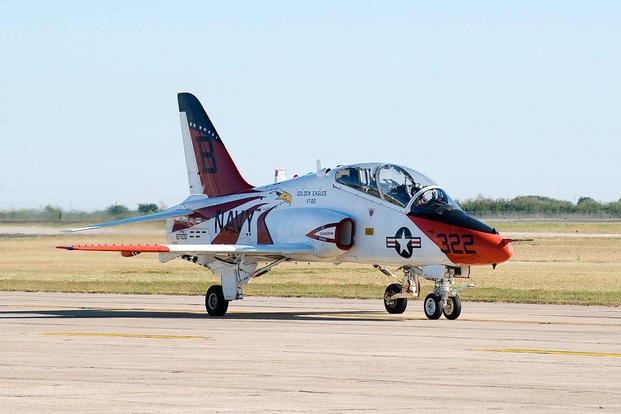Less than a day after T-45 Goshawk instructor pilots took to the air after a 12-day safety grounding, two pilots reported headaches and oxygen deprivation issues during a single flight, Military.com has learned.
In light of the incident, the Navy has doubled down on altitude restrictions, limiting instructor pilots to 5,000 feet and less than two Gs of force.
Cmdr. Jeannie Groeneveld, a spokeswoman for Naval Air Forces, told Military.com the incident took place near the previous safety-restricted altitude of 10,000 feet, when a senior instructor pilot out of the Naval Air Station Kingsville, Texas, training command was performing maneuvers and pulling in excess of 4 Gs. The pilots were intentionally performing challenging maneuvers to understand the limits of new restrictions and procedures, she said.
"When we did the deep dive with our medical folks and talked through it with them, it was more like an event where you're exerting energy at high altitude," Groeneveld said, adding that the pilot's symptoms subsided after descending to a lower altitude. This contrasts with previous cockpit hypoxia-like episodes that persisted even when pilots would use emergency oxygen and descend in altitude.
The Navy grounded all 197 of its T-45 trainers earlier this month after a reported 100 instructor pilots refused to fly, citing concerns about the safety of the aircraft due to a recent spike in these cockpit incidents. The problem was cast in especially sharp relief when an instructor pilot and a trainee ejected from a T-45 near the Meridian, Mississippi, training command after experiencing hypoxia-like symptoms.
Naval Air Forces announced that senior pilots would begin flying again April 18 without students to record their experiences and brief the command. It imposed an altitude limit of 10,000 feet, and ordered that pilots' masks be reconfigured to bypass the onboard oxygen generation systems. As of Thursday, Groeneveld said, senior pilots have completed 92 flights, with just the one reporting issues.
Pilots have also provided feedback about the new mask configuration, complaining that the restraint connecting the mask to the flight vest was coming loose, she said.
"We are re-evaluating the new mask configuration based on feedback aircrew conveyed after their flights," she said in a statement. "Safety is our priority; we will ensure that all mitigations are implemented, required procedural changes identified and communicated with all our aviators."
In the wake of the cockpit episode in Kingsville, the Navy sent engineers to the command as a precautionary measure, though they don't believe the incident is connected to previous problems.
The 10,000-foot altitude restriction meant that pilots could conduct only about 75 percent of the operational flight envelope for the T-45, officials have said. Groeneveld said it isn't immediately clear how the new restrictions will further limit operations.
"At this point, we're not doing any of the syllabus because we're not flying students, so we're just doing currency flights," she said.
She added that high-altitude operations were generally limited to dogfight and combat flight training, and much of what took place between 5,000 and 10,000 feet for the trainers was limited to transit. The pilots are also unable to conduct carrier landings with the restrictions in place.
Since the senior instructor pilots began flying again this week, she said, she is not aware of any new requests not to fly.
-- Hope Hodge Seck can be reached at hope.seck@military.com. Follow her on Twitter at@HopeSeck.






























